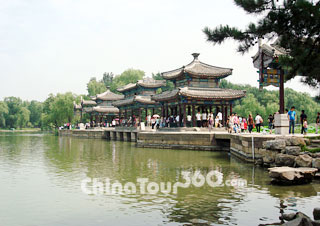 Chengde Summer Resort
Chengde Summer Resort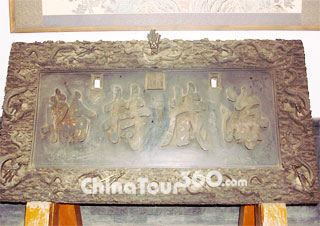 Cultural Relic, Summer Resort
Cultural Relic, Summer Resort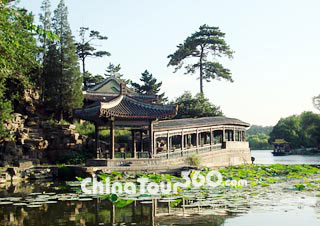 Beautiful Scenery in Summer Resort
Beautiful Scenery in Summer Resort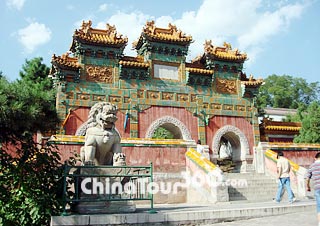 Temple of the Potaraka Doctrine
Temple of the Potaraka Doctrine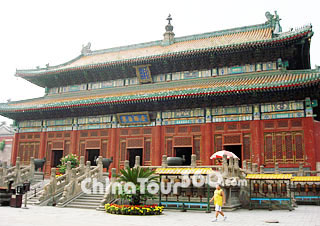 Puning Temple
Puning Temple
![]() Facts:
Facts:
Phone Code: 0314
Postal Code: 067000
Area: 39,519 square kilometers (15,254.3 square miles)
Population: 3,473,197 (statistics in 2010)
Nationalities: Han, Hui, Manchu, Mongolian and Chaoxian
Neighboring Areas: Beijing and Tianjin Municipalities; Shandong, Henan, Shanxi, and Liaoning Provinces; Inner Mongolia Autonomous Region
Location: Chengde is located in the northeast of Hebei province between latitudes 40°11′-42°40′N, and longitudes 115°54′-119°15′E.
![]() Physical Features: Situated at the transitional region between North China and Northeast China, Chengde is at the heartland of the Yanshan Mountains as well as the confluence of the Luanhe River and Wulie River. The urban area of the city is situated in the basin west of the Wulie River, with average altitude of 350 meters (1,148 feet). In short, it is surrounded by mountains (Qilaotu Mountain to its north, Yanshan Mountains to its south, and many other mountains like Wuling Mountain). Its landform mainly consists of plateau and hilly areas. In addition, land resources in the city are tremendous, including vast forests and broad grassland.
Physical Features: Situated at the transitional region between North China and Northeast China, Chengde is at the heartland of the Yanshan Mountains as well as the confluence of the Luanhe River and Wulie River. The urban area of the city is situated in the basin west of the Wulie River, with average altitude of 350 meters (1,148 feet). In short, it is surrounded by mountains (Qilaotu Mountain to its north, Yanshan Mountains to its south, and many other mountains like Wuling Mountain). Its landform mainly consists of plateau and hilly areas. In addition, land resources in the city are tremendous, including vast forests and broad grassland.
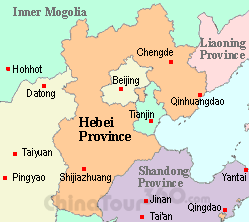
![]() History: From the Neolithic Age, early humans have lived on this land according to the cultural relics unearthed here. With original name ‘Rehe’, it belonged to the Yan State in the Warring States Period (476 BC - 221 BC). During the Qing Dynasty (1644 AD - 1911AD), it used to be the second political center to Beijing because the Mountain Resort of Chengde was built as a place for emperors to deal with state affairs as well as a royal garden. In 1982, it was selected as a state-level historical and cultural city by State Council.
History: From the Neolithic Age, early humans have lived on this land according to the cultural relics unearthed here. With original name ‘Rehe’, it belonged to the Yan State in the Warring States Period (476 BC - 221 BC). During the Qing Dynasty (1644 AD - 1911AD), it used to be the second political center to Beijing because the Mountain Resort of Chengde was built as a place for emperors to deal with state affairs as well as a royal garden. In 1982, it was selected as a state-level historical and cultural city by State Council.
![]() Attractions: Chengde is a famous tourist city in China. There are over 1,300 cultural relics and historic sites both on and under the ground, most of which are well-preserved. Chengde Mountain Resort, the largest royal garden in China (twice the size of Summer Palace in Beijing), is especially famous throughout the world. The Mountain Resort and its outlying temples (also called Eight Outer Temples) were inscribed on the UNESCO’s World Heritage List in 1994. The Putuo Zongcheng Temple and Puning Temple in the north of Chengde Mountain Resort are equally famed among the Eight Outer Temples. Pule Temple on a hillock in the northeast of the Mountain Resort also possesses high historical and artistic value. In addition, Qingchuifeng National Forest Park which encircles the Chengde urban area is famous for its Danxia landform (The Danxia landform refers to various landscapes found in southeast and southwest China that "consist of a red bed characterized by steep cliffs".).
Attractions: Chengde is a famous tourist city in China. There are over 1,300 cultural relics and historic sites both on and under the ground, most of which are well-preserved. Chengde Mountain Resort, the largest royal garden in China (twice the size of Summer Palace in Beijing), is especially famous throughout the world. The Mountain Resort and its outlying temples (also called Eight Outer Temples) were inscribed on the UNESCO’s World Heritage List in 1994. The Putuo Zongcheng Temple and Puning Temple in the north of Chengde Mountain Resort are equally famed among the Eight Outer Temples. Pule Temple on a hillock in the northeast of the Mountain Resort also possesses high historical and artistic value. In addition, Qingchuifeng National Forest Park which encircles the Chengde urban area is famous for its Danxia landform (The Danxia landform refers to various landscapes found in southeast and southwest China that "consist of a red bed characterized by steep cliffs".).
![]() Transportation: Usually, tourists take long-distance buses or trains by way of Beijing when traveling to Chengde. Since it is situated in a mountainous area, railways and highways there are inconvenient.
Transportation: Usually, tourists take long-distance buses or trains by way of Beijing when traveling to Chengde. Since it is situated in a mountainous area, railways and highways there are inconvenient.
![]() Air: Chengde Airport is expected to be open in 2012. It will operate flights to Shijiazhuang, Harbin, Shanghai, and Xian then.
Air: Chengde Airport is expected to be open in 2012. It will operate flights to Shijiazhuang, Harbin, Shanghai, and Xian then.
![]() Train: Chengde Railway Station is in the northeast of the city, and there are trains to Beijing, Tianjin, Shijiazhuang, Shenyang, Baotou, Dandong, Wulanhaote, Chifeng, and Jinzhou. Moreover, at Chengde Railway Station, visitors can buy tickets for trains from Beijing to other cities in China.
Train: Chengde Railway Station is in the northeast of the city, and there are trains to Beijing, Tianjin, Shijiazhuang, Shenyang, Baotou, Dandong, Wulanhaote, Chifeng, and Jinzhou. Moreover, at Chengde Railway Station, visitors can buy tickets for trains from Beijing to other cities in China.
![]() Bus: The route of the tourism highway decreased the time needed between Beijing and Chengde by 2 hours. Chengde Long-distance Bus Station provides buses to Shijiazhuang, Tianjin, Tangshan, Qinhuangdao, Chifeng, Zhangjiakou, and Langfang. Chengde North Bus Station and West Bus Station operate buses to other counties in the city. The city bus system is convenient and efficient as well, and the bus fare is RMB 1.
Bus: The route of the tourism highway decreased the time needed between Beijing and Chengde by 2 hours. Chengde Long-distance Bus Station provides buses to Shijiazhuang, Tianjin, Tangshan, Qinhuangdao, Chifeng, Zhangjiakou, and Langfang. Chengde North Bus Station and West Bus Station operate buses to other counties in the city. The city bus system is convenient and efficient as well, and the bus fare is RMB 1.
![]() Taxi: The minimum taxi charge is RMB 7 and total fare is not more than RMB 10 if traveling within the urban area.
Taxi: The minimum taxi charge is RMB 7 and total fare is not more than RMB 10 if traveling within the urban area.
![]() Weather: Under the influence of the temperate continental monsoon climate, the city has four distinct seasons, cold in winter but cool in summer due to its hill-shaped terrains. April to October is recommended as the best visiting times.
Weather: Under the influence of the temperate continental monsoon climate, the city has four distinct seasons, cold in winter but cool in summer due to its hill-shaped terrains. April to October is recommended as the best visiting times.
![]() Dining and Shopping
Dining and Shopping
Since Chengde was served as a fortress in the north of the Great Wall in ancient China, as well as the place where Manchu gathered, the dishes here are representative of the locally caught produce, such as venison, hare, and pheasant. The most famous dishes in the city are Qi Guo Ye Wei Ba Xian (Braised Game Dishes), Kou Mo (Sauteed Button Mushrooms with Broccoli), and Yu Tu He Ye Ji (Baked Chicken Wrapped with Lotus Leaf). The flavor snacks include Nansha Cake Buckwheat Vermicelli; Pan- fried Wantuo, Rose Cake, Pingquan Mutton Soup, Tea Candy.
Chengde has a variety of local products due to its abundant natural resources around. Famed ones are almonds, Dabian apricots, chestnuts, filberts, wild fern, mushrooms, and Chinese dwarf cherry. In addition, traditional crafts by minorities are also famous throughout China. Main specialties are hanging brocade of Summer Resort, woodcarving, and paper-cuts. Teng Cloth-pasted Picture is unique in China because it adopts the strong points of the painting, carving, embroidering, mounting and paper-cuting. The recommended shopping places are Xinxing Street, Wen Jia Gou, and Puning Street.







